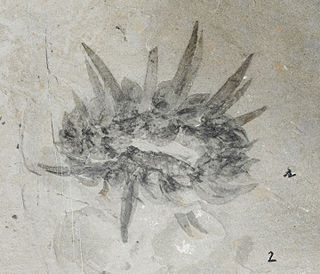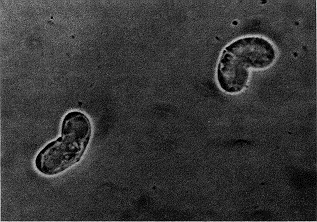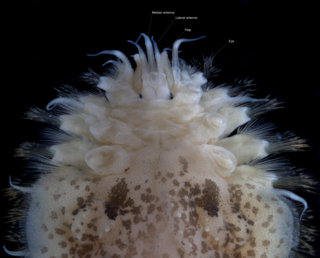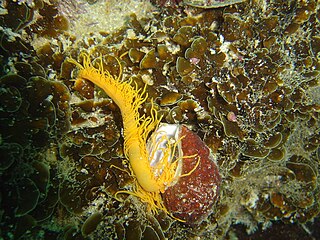Acicula (SG: aciculum) are strong, stout internal chaetae that provide support to parapodia in polychaete annelids. [1]

Acicula (SG: aciculum) are strong, stout internal chaetae that provide support to parapodia in polychaete annelids. [1]


Polychaeta is a paraphyletic class of generally marine annelid worms, commonly called bristle worms or polychaetes. Each body segment has a pair of fleshy protrusions called parapodia that bear many bristles, called chaetae, which are made of chitin. More than 10,000 species are described in this class. Common representatives include the lugworm and the sandworm or clam worm Alitta.

Orthonectida is a small phylum of poorly known parasites of marine invertebrates that are among the simplest of multi-cellular organisms. Members of this phylum are known as orthonectids.

Wiwaxia is a genus of soft-bodied animals that were covered in carbonaceous scales and spines that protected it from predators. Wiwaxia fossils – mainly isolated scales, but sometimes complete, articulated fossils – are known from early Cambrian and middle Cambrian fossil deposits across the globe. The living animal would have measured up to 5 cm (2 inch) when fully grown, although a range of juvenile specimens are known, the smallest being 2 millimetres (0.079 in) long.

In invertebrates, the term parapodium refers to lateral outgrowths or protrusions from the body. Parapodia are predominantly found in annelids, where they are paired, unjointed lateral outgrowths that bear the chaetae. In several groups of sea snails and sea slugs, 'parapodium' refers to lateral fleshy protrusions.

A chaeta or cheta is a chitinous bristle or seta found in annelid worms,. Polychaete annelids, are named for their chaetae. In Polychaeta, chaetae are found as bundles on the parapodia, paired appendages on the side of the body. The chaetae are epidermal extracellular structures, and clearly visible in most polychaetes. They are probably the best studied structures in these animals. Segments bearing chaetae are called chaetigers.

Ceratonova shasta is a myxosporean parasite that infects salmonid fish on the Pacific coast of North America. It was first observed at the Crystal Lake Hatchery, Shasta County, California, and has now been reported from Idaho, Oregon, Washington, British Columbia and Alaska.

The prostomium is the cephalized first body segment in an annelid worm's body at the anterior end. It is in front of the mouth, being usually a small shelf- or lip-like extension over the dorsal side of the mouth. The prostomium together with the peristomium, which includes the mouth and pharynx, make up the annelid head.

Odontogriphus is a genus of soft-bodied animals known from middle Cambrian Lagerstätte. Reaching as much as 12.5 centimetres (4.9 in) in length, Odontogriphus is a flat, oval bilaterian which apparently had a single muscular foot and a "shell" on its back that was moderately rigid but of a material unsuited to fossilization.
A bacterivore is an organism which obtains energy and nutrients primarily or entirely from the consumption of bacteria. The term is most commonly used to describe free-living, heterotrophic, microscopic organisms such as nematodes as well as many species of amoeba and numerous other types of protozoans, but some macroscopic invertebrates are also bacterivores, including sponges, polychaetes, and certain molluscs and arthropods. Many bacterivorous organisms are adapted for generalist predation on any species of bacteria, but not all bacteria are easily digested; the spores of some species, such as Clostridium perfringens, will never be prey because of their cellular attributes.

Terebellida make up an order of the Polychaeta class, commonly referred to as "bristle worms". Together with the Sabellida, the Spionida and some enigmatic families of unclear taxonomic relationship, they make up the subclass Canalipalpata, one of the three main clades of polychaetes. Like most polychaetes, almost all members of the Terebellida are marine organisms. Most are small, sessile detritivores which live in small tubes they build from mud or similar substrate, or burrow in the sand. Their central nervous system displays characteristic apomorphies.

Eunicida is an order of polychaete worms.

Errantia is a diverse group of marine polychaete worms in the phylum Annelida. Traditionally a subclass of the paraphyletic class Polychaeta, it is currently regarded as a monophyletic group within the larger Pleistoannelida, composed of Errantia and Sedentaria. These worms are found worldwide in marine environments and brackish water.
Angeiocystis is a genus of parasitic alveolate eukaryotes belonging to the phylum Apicomplexa.
Blastogregarinorina is a suborder of parasitic alveolates of the phylum Apicomplexia

The annelids, also known as the segmented worms, are a large phylum, with over 22,000 extant species including ragworms, earthworms, and leeches. The species exist in and have adapted to various ecologies – some in marine environments as distinct as tidal zones and hydrothermal vents, others in fresh water, and yet others in moist terrestrial environments.

The Shinkai 2000 (しんかい) was a crewed research submersible that could dive up to a depth of 2,000 meters. It was completed in 1981 and until 1991 it had the greatest depth range of any crewed research vehicle in Japan. The Shinkai 2000 was owned and run by the Japan Agency for Marine-Earth Science and Technology (JAMSTEC) and it was launched from the support vessel Natsushima.
Life That Glows is a 2016 British nature documentary programme made for BBC Television, first shown in the UK on BBC Two on 9 May 2016. The programme is presented and narrated by Sir David Attenborough.

Eunice aphroditois is a benthic bristle worm of warm marine waters, found in the Atlantic Ocean and the Indo-Pacific. It ranges in length from less than 10 cm (4 in) to 3 m (10 ft). Its iridescent cuticle produces a wide range of colors, from black to purple. This species is an ambush-predator; it hunts by burrowing its whole body in soft sediment on the ocean floor and waiting until its antennae detect prey. It then strikes with its sharp mouthparts. It may also be found among coral reefs.

Sedentaria is a diverse clade of annelid worms. It is traditionally treated as a subclass of the paraphyletic class Polychaeta, but it is also a monophyletic group uniting several polychaetes and the monophyletic class Clitellata. It is the sister group of Errantia.

Pleistoannelida is a group of annelid worms that comprises the vast majority of the diversity in phylum Annelida. Discovered through phylogenetic analyses, it is the largest clade of annelids, comprised by the last common ancestor of the highly diverse sister groups Errantia and Sedentaria and all the descendants of that ancestor.